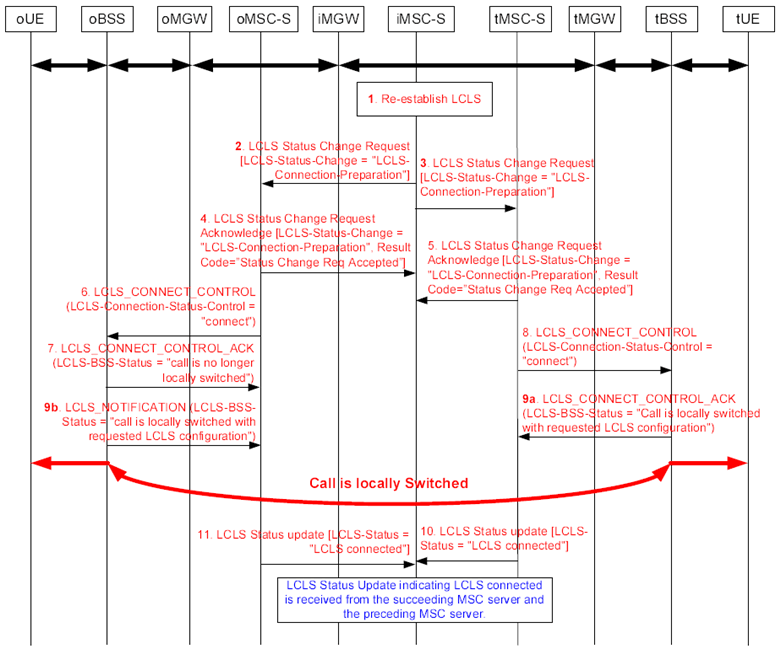Content for TS 23.284 Word version: 18.0.0
1…
4…
4.2…
4.3…
5
6…
6.3…
6.3.2
6.3.3
6.3.4
6.3.5
7…
7.2.4…
7.2.4.2
7.2.4.3
7.2.4.4
7.2.4.5
7.2.4.6
7.3…
7.3.4…
7.3.4.2
7.3.4.3
7.3.4.4
8…
8.2.3
8.3…
8.3.2
8.4…
8.4.1.1.7…
8.4.1.2…
8.4.2…
8.4.2.2…
8.4.5…
8.4.5.6
8.4.5.7
8.4.5.8…
9…
13…
13.4…
13.4.3…
13.4.4…
13.5…
13.6…
13.7…
14…
16…
A…
A.2…
7.3.4.3 Intermediate Node / GMSC Server Initiated Example Call Flow p. 62
Figure 7.3.4.3.1 shows the message sequence example for the Intermediate Node / GMSC Server initiated LCLS Re-establishment.

Figure 7.3.4.3.1: Intermediate Node / GMSC Server Initiated LCLS Re-establishment
(⇒ copy of original 3GPP image)
(⇒ copy of original 3GPP image)
Step 1.
The iMSC server determines that local switching should be established.
Step 2.
The iMSC server sends the LCLS Status Change Request message with the LCLS-Status-Change IE set to "LCLS-Connection-Preparation" to the oMSC server.
Step 3.
The iMSC server sends the LCLS Status Change Request message with the LCLS-Status-Change IE set to "LCLS-Connection-Preparation" to the tMSC server.
Step 4.
The oMSC server sends LCLS Status Change Request Acknowledge message to the succeeding node.
Step 5.
The tMSC server sends LCLS Status Change Request Acknowledge message to the preceding node.
Step 6.
The oMSC server sends to the oBSS the LCLS-Connect-Control message with the LCLS-Connection-Status-Control IE set to "connect".
Step 7.
The oBSS confirms the reception of the LCLS connect request but does not change the LCLS-BSS status since LCLS connect request is not yet received for the associated call leg.
Step 8.
The tMSC server sends to the tBSS the LCLS-Connect-Control message with the LCLS-Connection-Status-Control IE set to "connect".
Step 9a.
The tBSS reports the LCLS connection by sending the LCLS-Connect-Control Acknowledge message to the tMSC server.
Step 9b.
The oBSS reports the LCLS connection by sending the LCLS-Notification message to the oMSC server.
Step 10.
The tMSC server sends the LCLS Status Update message with the LCLS-Status IE set to "LCLS Connected" to the preceding node.
Step 11.
The oMSC server sends the LCLS Status Update message with the LCLS-Status IE set to "LCLS Connected" to the succeeding node.